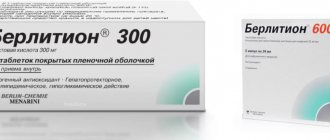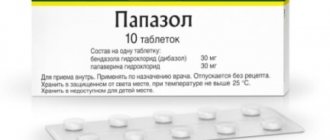Description and composition
The active ingredient of the drug is metformin hydrochloride (500 mg, 850 mg, 1000 mg). The drug has a hypoglycemic effect - it reduces blood glucose levels and normalizes lipid metabolism. It is used as monotherapy in the treatment of diabetes mellitus in adults and children. Metformin is included in the complex treatment of the disease with appropriate dosage adjustment.
Excipients: magnesium stearate, silicon dioxide, povidone, corn starch, propylene glycol, hypromellose, talc, titanium dioxide, polyethylene glycol.
Metformin - official instructions for use, analogues, price, availability in pharmacies
catad_pgroup Oral hypoglycemic agents Analogues, articles
Dosage form:
film-coated tablets
Compound:
Active ingredient: metformin hydrochloride 500 mg/850 mg: Excipients: Povidone K-30 35.0 mg/59.5 mg; Magnesium stearate 5.0 mg/8.5 mg.
Composition of the film shell (dry mixture of the film shell “Vivacoat PC-1P-058” from white to almost white) 16.0 mg/27.2 including: hypromellose 9.60/16.32 mg; talc 3.20 mg/5.44 mg; titanium dioxide 1.76 mg/2.
992 mg; macrogol 4000 (polyethylene glycol 4000) 1.44 mg/2.448 mg.
Description
Dosage 500 mg: round, biconvex, white or almost white film-coated tablets. Dosage 850 mg: capsule-shaped, biconvex tablets, film-coated, white or almost white.
Pharmacotherapeutic group
Hypoglycemic agent of the biguanide group for oral use.
Pharmacotherapeutic properties
Pharmacodynamics Metformin reduces hyperglycemia without leading to the development of hypoglycemia. Unlike sulfonylurea derivatives, it does not stimulate insulin secretion and does not have a hypoglycemic effect in healthy individuals. Increases the sensitivity of peripheral receptors to insulin and the utilization of glucose by cells.
Reduces the production of glucose by the liver by inhibiting glucogenesis and glycogenolysis. Delays the absorption of glucose in the intestine. Metformin stimulates glycogen synthesis and affects glycogen synthase. Increases the transport capacity of all types of membrane glucose transporters.
In addition, it has a beneficial effect on lipid metabolism: it reduces the content of total cholesterol, low-density lipoproteins and triglycerides.
While taking metformin, the patient's body weight either remains stable or decreases moderately.
Clinical studies have also shown the effectiveness of Metformin for the prevention of diabetes mellitus in patients with prediabetes with additional risk factors for the development of overt type 2 diabetes mellitus, in whom lifestyle changes have not allowed them to achieve adequate glycemic control.
Pharmacokinetics Absorption and distribution After oral administration, metformin is absorbed from the gastrointestinal tract quite completely. Absolute bioavailability is 50-60%.
The maximum concentration (Cmax) (approximately 2 μg/ml or 15 μmol) in plasma is reached after 2.5 hours. With simultaneous food intake, the absorption of metformin is reduced and delayed. Metformin is quickly distributed into tissues and practically does not bind to plasma proteins.
Metabolism and excretion Subject to very little metabolism and excreted by the kidneys. Metformin clearance in healthy subjects is 400 ml/min (4 times greater than creatinine clearance), indicating the presence of active tubular secretion.
The half-life is approximately 6.5 hours. In case of renal failure, it increases, and there is a risk of drug accumulation.
Indications for use
Type 2 diabetes mellitus, especially in obese patients, with ineffective diet therapy and exercise:
- In adults, as monotherapy or in combination with other oral hypoglycemic agents, or insulin;
- In children over 10 years of age as monotherapy or in combination with insulin.
Prevention of type 2 diabetes mellitus in patients with prediabetes with additional risk factors for developing type 2 diabetes mellitus in whom lifestyle changes have not allowed them to achieve adequate glycemic control.
Contraindications
- Hypersensitivity to metformin or to any excipient;
- Diabetic ketoacidosis, diabetic precoma, coma;
- Renal failure or impaired renal function (creatinine clearance less than 30 ml/min);
- Acute conditions with a risk of developing renal dysfunction: dehydration (with diarrhea, vomiting), severe infectious diseases, shock:
- Clinically pronounced manifestations of acute or chronic diseases that can lead to the development of tissue hypoxia (including acute heart failure, chronic heart failure with unstable hemodynamic parameters, respiratory failure, acute myocardial infarction);
- Major surgical operations and injuries, when insulin therapy is indicated (see section “Special Instructions”);
- Liver failure, liver dysfunction;
- Chronic alcoholism, acute alcohol poisoning;
- Pregnancy;
- Lactic acidosis (including history);
- Use within 48 hours before and within 48 hours after radioisotope or x-ray studies with the administration of an iodine-containing contrast agent (see section “Interaction with other drugs”;
- Following a hypocaloric diet (less than 1000 kcal/day);
- Children's age up to 10 years.
Carefully
Apply the drug
- In persons over 60 years of age who perform heavy physical work, which is associated with an increased risk of developing lactic acidosis;
- In patients with renal failure (creatinine clearance 30-59 ml/min);
- During breastfeeding;
- Children's age from 10 to 12 years.
Use during pregnancy and breastfeeding
Decompensated diabetes mellitus during pregnancy is associated with an increased risk of birth defects and perinatal mortality. Limited evidence suggests that taking metformin in pregnant women does not increase the risk of birth defects in their children.
When planning pregnancy, as well as in the event of pregnancy while taking metformin for prediabetes and type 2 diabetes mellitus, the drug should be discontinued, and insulin therapy should be prescribed in case of type 2 diabetes mellitus.
It is necessary to maintain the glucose level in the blood plasma at a level closest to normal to reduce the risk of fetal malformations.
Metformin passes into breast milk. No side effects were observed in breastfeeding newborns while taking metformin.
However, due to limited data, the use of the drug during breastfeeding is not recommended.
The decision to stop breastfeeding should be made taking into account the benefits of breastfeeding and the potential risk of side effects for the baby.
Pharmacological group
Metformin is an antidiabetic drug. Pharmacological group – hypoglycemic drugs. Metformin restores blood glucose levels by normalizing carbohydrate and lipid metabolism.
Pharmacodynamics
Metformin treats hyperglycemia (high blood sugar) without the risk of hypoglycemia (low blood sugar). The drug has no effect on insulin synthesis. The hypoglycemic effect occurs due to the inhibition of gluconeogenesis and glycogenolysis, which leads to a decrease in glucose production in the liver. The drug blocks the absorption of glucose by the intestinal mucosa, promotes the active uptake of glucose into the muscles and the formation of glycogen.
In addition to influencing carbohydrate metabolism, Metmorphin normalizes lipid metabolism. The drug restores cholesterol levels in the blood, reduces the formation of low-density lipoproteins (LDL) and very low-density lipoproteins (VLDL). The drug increases the sensitivity of cell membrane receptors to insulin, which increases the rate of glucose utilization and prevents the occurrence of hyperglycemia.
Pharmacokinetics
After entering the digestive tract, the drug is completely absorbed. The maximum concentration in the blood is after 2.5-3 hours. The bioavailability of the drug is 50-60%. Metformin hydrochloride slightly binds to plasma transport proteins. Partially penetrates into red blood cells. The half-life corresponds to 6.5 hours. Not metabolized in the liver. It is excreted from the body to a greater extent in the urine; a small part of the drug leaves the body unchanged in the feces.
Metformin
Metformin Metforminum ( gen.
Metformini)
N,N-Dimethylimdicarboimdiamide (as hydrochloride)
C4H11N5
- Hypoglycemic synthetic and other drugs
- E11 Non-insulin-dependent diabetes mellitus
657-24-9
Metformin hydrochloride is a white or colorless crystalline powder. It is highly soluble in water and practically insoluble in acetone, ether and chloroform. Molecular weight 165.63.
Pharmacological action – hypoglycemic.
Reduces the concentration of glucose (on an empty stomach and after meals) in the blood and the level of glycosylated hemoglobin, increases glucose tolerance.
Reduces intestinal absorption of glucose, its production in the liver, potentiates the sensitivity to insulin of peripheral tissues (increases the absorption of glucose and its metabolism).
Does not alter insulin secretion by beta cells of the pancreatic islets (fasting insulin levels and the 24-hour insulin response may even decrease).
Normalizes the lipid profile of blood plasma in patients with non-insulin-dependent diabetes mellitus: it reduces the content of triglycerides, cholesterol and LDL (determined on an empty stomach) and does not change the levels of lipoproteins of other densities. Stabilizes or reduces body weight.
Experimental studies on animals at doses 3 times higher than the MRDC in terms of body surface area did not reveal mutagenic, carcinogenic, teratogenic properties or effects on fertility.
Rapidly absorbed from the gastrointestinal tract. Absolute bioavailability (on an empty stomach) is 50–60%. Cmax in plasma is achieved after 2 hours. Eating reduces Cmax by 40% and slows its achievement by 35 minutes.
The equilibrium concentration of metformin in the blood is achieved within 24–48 hours and does not exceed 1 mcg/ml. The volume of distribution (for a single dose of 850 mg) is (654 ± 358) l. Slightly binds to plasma proteins and can accumulate in the salivary glands, liver and kidneys.
It is excreted by the kidneys (mainly by tubular secretion) unchanged (90% per day). Renal Cl - 350–550 ml/min. T1/2 is 6.2 hours (plasma) and 17.6 hours (blood) (the difference is explained by the ability to accumulate in red blood cells).
In the elderly, T1/2 is prolonged and Cmax increases. If renal function is impaired, T1/2 lengthens and renal clearance decreases.
Diabetes mellitus type 2 (especially in cases accompanied by obesity) with ineffective correction of hyperglycemia by diet therapy, incl. in combination with sulfonylureas.
Hypersensitivity, kidney disease or renal failure (creatinine level more than 0.132 mmol/l in men and 0.123 mmol/l in women), severe liver dysfunction; conditions accompanied by hypoxia (incl.
cardiac and respiratory failure, acute phase of myocardial infarction, acute cerebral circulatory failure, anemia); dehydration, infectious diseases, major surgery and trauma, chronic alcoholism, acute or chronic metabolic acidosis, including diabetic ketoacidosis with or without coma, history of lactic acidosis, following a low-calorie diet (less than 1000 kcal/day), conducting studies using radioactive iodine isotopes , pregnancy, breastfeeding.
Children's age (the effectiveness and safety of use in children have not been determined), elderly (over 65 years of age) age (due to slow metabolism, the benefit/risk ratio must be assessed). It should not be prescribed to people performing heavy physical work (the risk of developing lactic acidosis is increased).
During pregnancy, it is possible if the expected effect of therapy exceeds the potential risk to the fetus (adequate and strictly controlled studies on use during pregnancy have not been conducted).
Category of action on the fetus according to the FDA -
B.
Breastfeeding should be stopped during treatment.
From the gastrointestinal tract:
at the beginning of the course of treatment - anorexia, diarrhea, nausea, vomiting, flatulence, abdominal pain (reduced when taken with meals); metallic taste in the mouth (3%).
From the cardiovascular system and blood (hematopoiesis, hemostasis):
in isolated cases - megaloblastic anemia (the result of impaired absorption of vitamin B12 and folic acid).
From the side of metabolism:
hypoglycemia; in rare cases - lactic acidosis (weakness, drowsiness, hypotension, resistant bradyarrhythmia, respiratory disorders, abdominal pain, myalgia, hypothermia).
From the skin:
rash, dermatitis.
The effect of metformin is weakened by thiazide and other diuretics, corticosteroids, phenothiazines, glucagon, thyroid hormones, estrogens, incl. as part of oral contraceptives, phenytoin, nicotinic acid, sympathomimetics, calcium antagonists, isoniazid.
In a single dose in healthy volunteers, nifedipine increased absorption, Cmax (by 20%), AUC (by 9%) of metformin, Tmax and T1/2 did not change.
The hypoglycemic effect is enhanced by insulin, sulfonylurea derivatives, acarbose, NSAIDs, MAO inhibitors, oxytetracycline, ACE inhibitors, clofibrate derivatives, cyclophosphamide, beta-blockers.
In a single-dose interaction study in healthy volunteers, furosemide increased the Cmax (by 22%) and AUC (by 15%) of metformin (without significant changes in the renal clearance of metformin); Metformin reduces Cmax (by 31%), AUC (by 12%), and T1/2 (by 32%) of furosemide (without significant changes in the renal clearance of furosemide). There are no data on the interaction of metformin and furosemide with long-term use. Drugs (amiloride, digoxin, morphine, procainamide, quinidine, quinine, ranitidine, triamterene and vancomycin) secreted in the tubules compete for tubular transport systems and with long-term therapy can increase the Cmax of metformin by 60%. Cimetidine slows down the elimination of metformin, which increases the risk of developing lactic acidosis. Incompatible with alcohol (increased risk of developing lactic acidosis).
Symptoms:
lactic acidosis
Treatment:
hemodialysis, symptomatic therapy.
Inside.
Kidney function, glomerular filtration, and blood glucose levels should be constantly monitored. Particularly careful monitoring of blood glucose levels is necessary when using metformin in combination with sulfonylureas or insulin (risk of hypoglycemia).
Combined treatment with metformin and insulin should be carried out in a hospital until an adequate dose of each drug is established. In patients on continuous therapy with metformin, it is necessary to determine the level of vitamin B12 once a year due to a possible decrease in its absorption.
It is necessary to determine the level of lactate in plasma at least 2 times a year, as well as when myalgia appears. If the lactate level increases, the drug is discontinued.
Do not use before surgical operations and within 2 days after them, as well as within 2 days before and after diagnostic studies (iv urography, angiography, etc.).
Go
Source: https://www.rlsnet.ru/mnn_index_id_182.htm
Indications for use
For adults
Metformin is prescribed to adults as monotherapy and included in complex treatment along with other hypoglycemic drugs or insulin. The drug is taken as a hypoglycemic agent for non-insulin-dependent diabetes mellitus (type 2) in case of ineffectiveness of the hypoglycemic diet.
For children
Metformin is indicated for a child from 10 years of age as a separate treatment and is included in combination therapy along with insulin. The drug is taken to eliminate hyperglycemia in non-insulin-dependent diabetes mellitus (type 2), especially in the setting of obesity.
For pregnant women and during lactation
During all trimesters of pregnancy, the drug is discontinued to prevent the risk of toxic effects on the child's body. Hypoglycemic therapy is continued with insulin injections. There are no clinical trials regarding the penetration of the drug into breast milk. Metformin is not prescribed during lactation.
Dosage
Metformin is available in tablets of 500 mg, 850 and 1000, 30 or 60 pieces in a blister. Take them after meals, swallowing whole and drinking plenty of water.
In the first days, the dose is 1000 mg of metformin, divided into 2-3 servings. If a large tablet is difficult to swallow right away, you can break it in half. From the 4th day, take 1 g three times a day, and from the 15th, the amount is reduced depending on the test results. The full effect becomes obvious after two weeks.
When treating with metformin in combination with insulin, in the first days its dosage does not change, and then you should switch to a gradually decreasing volume under constant medical supervision. Maintenance daily dosage of metformin is 1-2g.
Doctors prescribe a more precise amount of the drug, taking into account the patient’s condition, the previously used regimen and the results of control tests.
Sometimes complex treatment of non-insulin-dependent diabetes is carried out with the drug glibenclamide metformin. The first element of the composition stimulates the secretion and release of insulin, and the second increases sensitivity to insulin. An overdose of glibenclamide with metformin can cause hypoglycemia, so its use requires constant monitoring of analytical data by a physician. They are received at least twice a day - on an empty stomach and after one meal.
A double drug (glibenclamide + metformin) is prescribed to patients who have not been helped by monotherapy with one of them or in combination with other drugs. It is taken with food. The dosage is selected individually. It is usually customary to start treatment with 1 tablet containing 500 mg of metformin and 2.5 mg of glibenclamide. The dose is adjusted every 1-2 weeks based on glycemic levels.
Contraindications
Before starting therapy, it is necessary to take into account contraindications to prevent the development of complications.
- Individual intolerance to metformin hydrochloride and other components of the drug.
- Chronic and acute renal failure in the stage of decompensation.
- Chronic and acute liver failure.
- Alcoholism, alcohol intoxication.
- Chronic heart failure.
- Severe respiratory failure.
- Myocardial infarction.
- Shock.
When combined with other hypoglycemic drugs, it is necessary to adjust the dosage based on blood glucose concentrations.
special instructions
During therapy, it is necessary to monitor the condition of the kidneys. At least 2 times a year and if muscle pain occurs, you should check the lactate level in the body.
The drug can be taken in combination with sulfonylurea derivatives, and the level of glucose in the blood must be monitored.
Formetine does not affect the ability to drive, but when prescribed with other hypoglycemic agents, hypoglycemia may develop, which impairs the ability to drive.
Before taking it, it is recommended to consult a specialist.
Application and dosage
For adults
Metformin is used as monotherapy and is also included in combination treatment regimens with other hypoglycemic agents or insulin.
Monotherapy and complex treatment with hypoglycemic drugs. The initial dose corresponds to 500-850 mg 2-3 times a day. The maximum daily dosage is 3000 mg. The drug is taken during or after meals. The dose of the drug is increased slowly over 10-14 days according to the results of the glycemic profile. When prescribing high doses of the drug, 1000 mg tablets are used.
Complex therapy with insulin. The initial dose corresponds to 500-850 mg 2-3 times a day. The insulin dose is adjusted according to the glycemic profile.
For children
Metformin is prescribed to children from 10 years of age as monotherapy 500-850 mg once a day. If necessary, the dosage is increased over 10-14 days. The maximum daily dose is 2000 mg. In the case of combination treatment, the dosage of insulin is adjusted according to the therapeutic response to treatment based on blood glucose levels.
For pregnant women and during lactation
The drug is not prescribed during pregnancy and breastfeeding.
Metformin
Gluconil, Siofor, Glucophage, Apsafage, Bagomet, Glycomed, Metlong, Metlong DS, Metfogamma, MetforPanfor SRSofamet
Pharmacological group
Active substances, Hypoglycemic synthetic and other agents
Recipe
Rp: Metformini 0.5D.td: No. 100 in tab.
S: 1 tablet 2 times a day (during or after meals)
Prescription form 107-1/у
pharmachologic effect
Metformin (dimethylbiguanide) is an antidiabetic agent for internal use that belongs to the biguanide class. The effectiveness of Metformin is associated with the ability of the active substance to inhibit gluconeogenesis in the body. The active substance inhibits the transport of electrons in the mitochondrial respiratory chain.
This leads to a decrease in the concentration of ATP inside cells and stimulation of glycolysis, carried out in an oxygen-free way. As a result, the entry of glucose into cells from the extracellular space increases, and the production of lactate and pyruvate in the liver, intestines, fat and muscle tissues increases. Glycogen reserves in liver cells also decrease.
Does not cause hypoglycemic effects because it does not activate insulin production. Reduces fat oxidation processes and inhibits the production of free fatty acids. With the use of the drug, a change in the pharmacodynamics of insulin is observed due to a decrease in the ratio of bound insulin to free insulin. An increase in the insulin/proinsulin ratio is also detected.
Due to the mechanism of action of the drug, there is a decrease in the level of glucose in the blood serum after eating food, and the baseline glucose level also decreases.
Due to the fact that the drug does not stimulate the production of insulin by beta cells of the pancreas, it stops hyperinsulinemia, which is considered one of the most important factors in weight gain in diabetes mellitus and the progression of vascular complications.
A decrease in glucose levels occurs due to improved absorption of glucose by muscle cells and an increase in the sensitivity of peripheral receptors to insulin. In healthy people (without diabetes), no decrease in glucose levels is observed when taking metformin.
Metformin helps reduce body weight in obesity and diabetes by suppressing appetite, reducing the absorption of glucose from food in the gastrointestinal tract and stimulating anaerobic glycolysis. Metformin also has a fibrinolytic effect due to the inhibition of PAI-1 (tissue-type plasminogen activator inhibitor) and t-PA (tissue plasminogen activator).
The drug stimulates the process of biotransformation of glucose into glycogen and activates blood circulation in the liver tissue. Hypolipidemic property: reduces the level of LDL (low-density lipoprotein), triglycerides (by 10-20% even with an initial increase of 50%) and VLDL (very low-density lipoprotein).
Due to its metabolic effects, metformin causes an increase in HDL (high-density lipoprotein) levels by 20-30%. The drug inhibits the development of proliferation of smooth muscle elements of the vascular wall. It has a positive effect on the cardiovascular system and prevents the appearance of diabetic angiopathy.
After oral administration, the maximum concentration of the active substance in the blood plasma is achieved after 2.5 hours. In patients receiving the drug in the maximum permissible dosages, the highest content of the active substance in the blood plasma did not exceed 4 mcg/ml.
6 hours after taking the tablet, absorption of the active substance from the drug ends, which is accompanied by a decrease in the plasma concentration of metformin. When taking the recommended dosages, after 1-2 days constant concentrations of metformin are found in the blood plasma within 1 mcg/ml or less.
If you take the drug while eating food, there is a decrease in the absorption of metformin from the drug. Metformin is mainly accumulated in the walls of the digestive tube: in the small and duodenal intestines, stomach, as well as in the salivary glands and liver. The half-life is about 6.5 hours. When metformin is used internally, the absolute bioavailability in healthy individuals is approximately 50–60%. Slightly binds to plasma proteins. With the help of tubular secretion and glomerular filtration, 20 to 30% of the administered dose is excreted by the kidneys (unchanged, since, unlike formin, it is not metabolized). With impaired renal function, renal clearance decreases in proportion to creatinine clearance, therefore, accordingly, the plasma concentration and half-life of metformin from the body increase, which can cause accumulation of the active substance in the body.
Mode of application
Metformin tablets are swallowed whole with plenty of water. The drug should be taken only after meals. If the patient has difficulty swallowing a tablet (for example, 850 mg tablets), then it is divided into 2 parts to make it easier to take. In this case, both halves must be taken at once, one after the other.
The initial dosage of Metformin is 1000 mg/day. Dividing the daily dosage into 2 or 3 doses can lead to a significant reduction in side effects from the digestive system. The dose of Metformin can be gradually increased after 10–15 days. The dose of the drug is selected taking into account the patient’s glucose profile. Maintenance dosage is 1500 to 2000 mg/day.
The maximum permissible dose is 3000 mg/day.
The drug is taken by elderly people only taking into account data from continuous monitoring of renal function. Full therapeutic activity is observed 2 weeks after taking the drug.
If you need to switch to Metformin from another hypoglycemic oral drug, then the previous drug should be discontinued, and then therapy with Metformin should be started within the recommended dosage. When combining insulin and Metformin, the insulin dosage is not changed in the first 4–6 days.
In the future, if this turns out to be necessary, the insulin dose is gradually reduced - over the next few days by 4-8 IU. If the patient receives more than 40 units of insulin per day, then reducing its dose while using Metformin is carried out only in the hospital, since it requires great caution.
Indications
Prescribed for adults with diabetes mellitus types 1 and 2.
Metformin is used as an addition to the main therapy with insulin or other antidiabetic drugs, as well as in the form of monotherapy (for type 1 diabetes, it is used only in combination with insulin).
It is especially recommended in the presence of concomitant obesity in cases where the necessary control of blood glucose levels is not achieved through adequate physical activity or diet alone.
Contraindications
• Children's age (up to 15 years); • hypersensitivity to the active substance or to any of the components of Metformin; • diabetic precoma; • renal dysfunction or renal failure (serum creatinine level in men 135 µmol/l and above, in women 110 µmol/l and above); • diabetic ketoacidosis; • gangrene; • dehydration of the body (with vomiting or diarrhea); • diabetic foot syndrome; • some acute conditions that can potentially cause deterioration in the functioning of the kidney tissue (for example, severe infectious diseases, dehydration, shock); • acute myocardial infarction; • insufficiency of adrenal gland function; • following a diet with a daily calorie content of less than 1000 kcal; • liver failure; • lactic acidosis (including anamnestic indication of lactic acidosis); • severe infectious diseases; • chronic alcoholism; • acute or chronic pathological conditions that cause tissue hypoxia (for example, respiratory or heart failure, shock, indication of recent myocardial infarction); • fever; • major trauma or major surgery (especially when insulin is indicated); • intra-arterial or intravenous use of radiopaque agents containing iodine; • acute alcohol poisoning;
• During pregnancy and breastfeeding.
Side effects
The most common side effects of Metformin (10% or more) are effects on the digestive system: diarrhea, nausea, vomiting, loss of appetite, abdominal pain, metallic taste in the mouth. Usually these undesirable effects appear at the beginning of taking the drug.
In the prevailing number of observations, side effects from the digestive system quickly and independently disappear even if Metformin is continued. In case of hypersensitivity to the active substance, moderate erythema is observed (very rare).
Discontinuation of metformin requires the patient to develop lactic acidosis (a very rare side effect). With prolonged use of the drug, some patients experience a decrease in the absorption of cyanocobalamin (vitamin B12) and a decrease in its level in the blood serum.
This can cause megaloblastic anemia and hematopoietic disorders.
Side effects
Side effects more often occur as a result of treatment with high doses of the drug, especially against the background of insufficient liver and kidney function.
- Abdominal pain, nausea, vomiting, metallic taste in the mouth, diarrhea.
- Skin itching, urticaria, erythema.
In rare cases, megaloblastic anemia develops. Hypoglycemia is detected in the blood.
Interaction with other drugs
The simultaneous use of Metformin and alcoholic beverages leads to the development of a serious complication - lactic acidosis. The same effect can be caused by the parallel administration of iodine-containing contrast agents for diagnostic procedures. Treatment with Metformin while taking danazol, diuretics, glucocorticosteroids, beta sympathomimetics, chlorpromazine increases the risk of developing persistent hyperglycemia. Simultaneous administration with ACE inhibitors enhances the hypoglycemic effect of Metformin.
Analogs
The following medications can be used instead of Metformin:
- Bagomet is a domestic drug containing metformin as an active ingredient. It is produced in the form of regular and extended-release tablets. They are contraindicated for pregnant women during breastfeeding.
- Bagomet Plus is a combination drug containing, in addition to metformin, glibenclamide. Both active ingredients reduce high sugar levels. The medicine is produced in tablets that are prohibited for pregnant and lactating women.
- Galvus Met is a combination medication containing, in addition to metformin, vildagliptin. Both active ingredients enhance the therapeutic effect of each other. The medicine is available in tablets, which are contraindicated for children, pregnant and lactating women.
- Glibomet is a combination medication containing metformin and glibenclamide. Both components lower high blood sugar levels and potentiate each other's action. The drug is available in tablets used for type 2 diabetes mellitus in adults.
Patient reviews
Glucophage (Metformin) for weight loss. When it should not be taken under any circumstances
ADVANTAGES: reduces appetite, or even completely discourages it. DISADVANTAGES: there may be serious side effects; for weight loss, Glucophage is not helpful if you are following a strict diet.
Let me make a reservation right away that my blood sugar level is absolutely normal, and has been so all the time. When I took scheduled tests in compliance with the preparation instructions (on an empty stomach, do not drink or eat), the values ranged from 3.8 to 4.6, no more.
Quick weight loss, but only for those who have problems with the pancreas
ADVANTAGES: cool, effective. DISADVANTAGES: may cause nausea, lack of appetite.
The drug is serious, it must be used wisely and only as prescribed by a doctor. I was diagnosed with insulin resistance (predisposition to type 2 diabetes) and was prescribed to drink glucophage.
Metformin "Glucophage" - Nausea, diarrhea and lack of appetite help you lose weight
ADVANTAGES: lost a lot of weight, lack of appetite. DISADVANTAGES: nausea, diarrhea.
I decided to try Glucophage out of desperation. I tried to lose weight on various diets and sports for a very long time. Nothing helped me.
Don't miss: Injections into the knee joint: a review of the best drugs
Metformin and its analogues are a bomb for the gastrointestinal tract
ADVANTAGES: quick weight loss. DISADVANTAGES: The consequences of taking the drug are chronic diseases of the entire digestive tract.
I took glucophage and lost 19 kilograms in 4 months. But now, for 12 years after this, I have been suffering from chronic pancreatitis, chronic gastroduadenitis, and reflux disease of the stomach.
Do not use unless indicated! This is not a weight loss product!
ADVANTAGES: effective, does not affect insulin levels and blood sugar. DISADVANTAGES: nausea with a single dose of 1000 mg, expensive.
Due to PCOS (polycystic ovary syndrome), I have insulin resistance (increased insulin and weight). The doctor prescribed Glucophage after meals in the amount of 1000 mg 3 times a day as therapy for weight loss (naturally, diet, sports and no carbohydrates).
Excellent drug for insulin resistance
ADVANTAGES: inexpensive, helps. DISADVANTAGES: lactic acidosis, not allowed with alcohol)
The doctor prescribed the drug to me, insulin resistance, insulin 16, sugar is normal. I prescribed 850 mg in the evening, before taking it I read the reviews and was horrified, I didn’t want to take it, but I had to.
Don't miss: Use of folic acid in the treatment of rheumatoid arthritis
Do you want to reduce your appetite and lose those annoying pounds? Metformin is not only for diabetes!
ADVANTAGES: helps even the laziest to lose weight effortlessly without physical activity. DISADVANTAGES: side effects.
I do not suffer from serious health problems, but there are minor age-related changes and difficulties in conceiving. A gynecologist once diagnosed “polycystic ovary syndrome” as questionable, and later the question resolved itself and the diagnosis was not confirmed!
Reduces insulin resistance. Relative safety
ADVANTAGES: reduces insulin resistance. Relative safety. DISADVANTAGES: Somewhat outdated.
I took the hypoglycemic drug Metformin from the very beginning of diagnosing insulin-independent type 2 diabetes in 2001. At that time, no one suffered from import substitution and the medicine came from abroad under different names.
Ozon "Metformin" tablets - For those who suffer from type 2 diabetes mellitus
ADVANTAGES: availability, normalize blood sugar levels. DISADVANTAGES: there are contraindications.
My mother-in-law's blood sugar has increased recently.
Another good remedy for diabetics
ADVANTAGES: effective, inexpensive. DISADVANTAGES: many contraindications.
I recently became acquainted with Ozon Metformin tablets. The fact is that our relative from the village stayed with us, or rather stayed for a week. She came to the cardio center for examination and stayed with us during this time. She is a diabetic, before this I perceived this diagnosis as a death sentence. But after talking with my aunt for a week, my opinion about diabetes changed.
Soviet rubbish and hack
ADVANTAGES: None! What tastes is what comes out! DISADVANTAGES: Feces are packaged.
People, this crap is given out in clinics. I have type 2 diabetes.
Disgusting
ADVANTAGES: None. DISADVANTAGES: Bitter pacifier.
Dummy. They gave it to my mother for free at the clinic. I took it for four days and my sugar rose!










